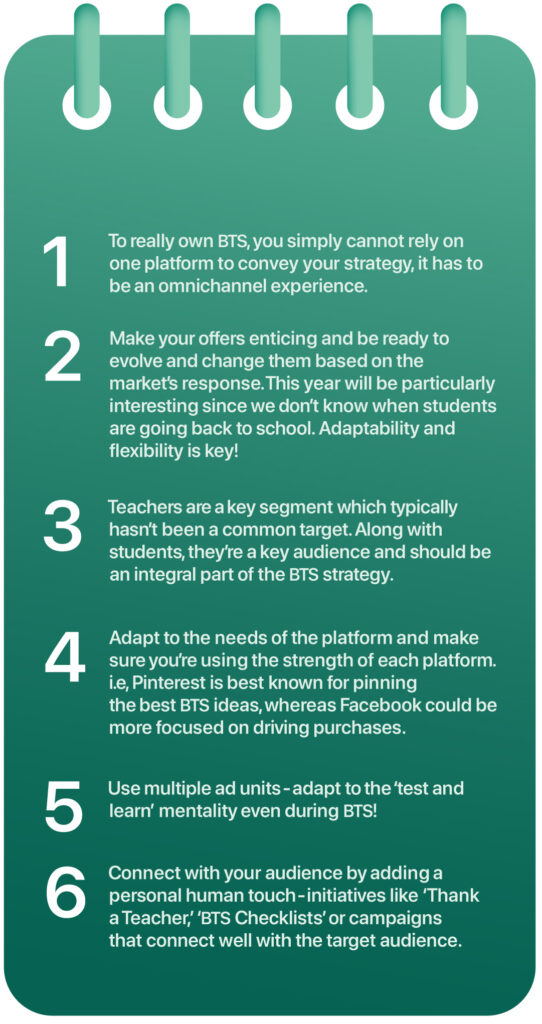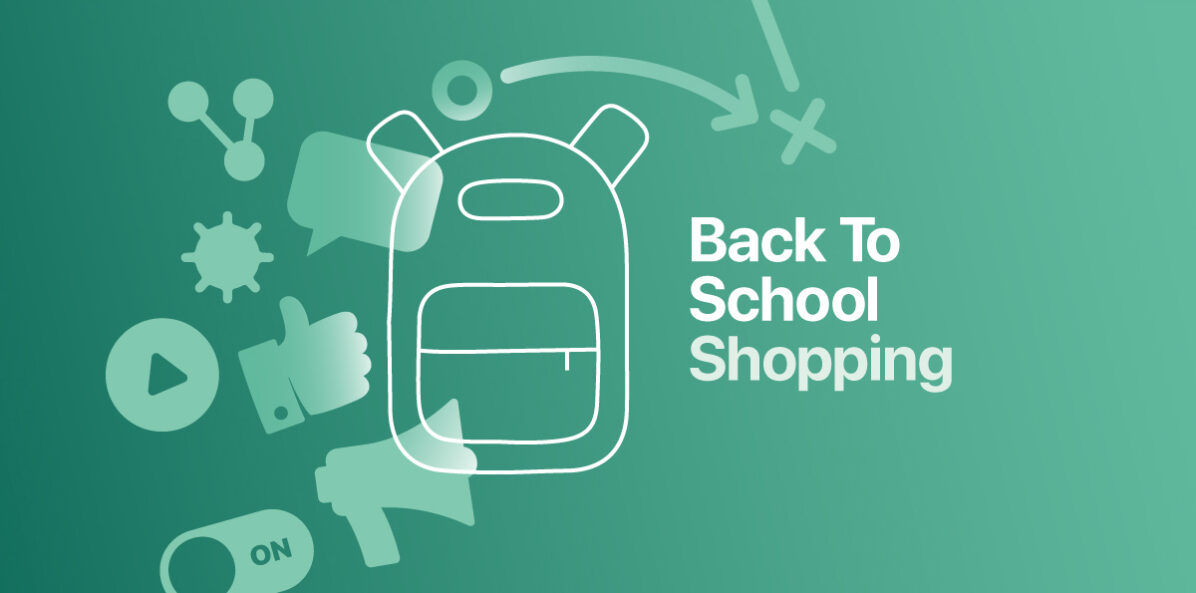Back to School season is upon us but things are looking a little different this year. Some students are going back to the classroom while others are learning virtually. As a retailer looking to promote your Back to School products, your campaigns must cater to all types of different audiences and scenarios. In this post, we’ll help you ace the school year with the latest shopping trends, top of class messaging and Back to School must-haves for your campaign.
New Shifts in Consumer Behaviour
Despite the disruption COVID-19 has caused to families, schools and businesses, Back to School spend is predicted to go up this year. According to Deloitte’s 2020 Back to School survey, consumers plan to spend $10.4 billion online this Back to School season, a $2.3 billion increase from 2019.
Similarly, data from Fluent Pulse shows that consumers’ spending patterns are on the rise; 27% of Americans have increased their online shopping since the onset of COVID-19 while 47% are making the same amount of online purchases.
For advertisers, there’s opportunity in online shopping and low-contact options, such as BOPIS (‘Buy Online, Pickup in Store’) as consumers are seeking out affordable and safe ways to shop in response to concerns of health and finances.
What factors are influencing their buying decisions? Price, convenience and safety. 82% said the price was the most important factor, followed by 80% naming convenience as their most important criteria. However, 59% also considered safety as an important element this year.
With some students returning to classrooms in the fall, others will be learning online and a percentage may not return to school until 2021. How can brands prepare and who should they advertise to? We highlight the different scenarios below and how retailers can respond accordingly.
Shift in Category Purchases
Overall, parents are shifting their purchasing behaviour in response to the various schooling scenarios—40% said they’re planning to buy fewer traditional school supplies this year as they invest in digital resources to support their children’s education. And since 52% of consumers feel unsafe going to the store, parents are planning to purchase more online this year to take advantage of contactless transactions such as delivery, curbside pickup and Buy Online, Pick Up In Store (BOPIS).
Back to School Scenarios and How Retailers Can Respond
Scenario #1: Back to normal, in time for mid-July back to school shopping?
Call us optimistic but if schools open in time for the fall semester, retailers must be prepared for the demand and ensure stock availability. “Those who do return to classrooms in the fall will need more items, like pencils, tissues and more”, said Ryan Wuerch, CEO at Dosh, he also noted an elevated demand for cleaning supplies required for disinfecting throughout the day in addition to a surge in PPE gear.
However, mid-July BTS sales are already looking different this year. Amazon’s annual Prime Day (usually in mid-July) has been postponed indefinitely. Deemed as a passage to the start of Back to School sales, the event won’t happen until at least August. Without Amazon’s event taking place in July, retailers are relying on their own promotions with large discounts to compete with Prime Day deals.
If BTS occurs during the traditional fall semester, retailers will need to consider nimble marketing channels with the ability to launch and execute quickly, like Facebook Ads (vs. Dynamic video).
“E-commerce sites must ensure their supply chains are ready for the influx. At the same time, brick and mortar stores will need to emphasize their hygiene protocol and institute curbside pickup or contactless payment options,” said Gazzuolo, senior director, Paid Media, Wpromote.
Scenario #2: The return to normalcy takes longer, impacting the Fall 2020 school semester
Schools might open later or shift completely to online classes. Some universities are contemplating delaying opening until 2021. In this instance, some categories like apparel and sporting goods (for school teams) may see a decrease in demand, while electronics and other technology for virtual learning could increase.
80% of parents have already invested in electronics and other tech, for example, according to a survey from SuperAwesome, which provides marketing insights around children’s data.
As a retailer, this opportunity could mean looking for new categories that you may not have considered before and using data points based on consumer browsing behavior to uncover new trends. For instance, the uncertainty around BTS is leading parents to cover all bases, which means that some items not generally on the back-to-school list, like desks and other furniture, are being purchased.
Stores could also take a geographic approach to back to school sales, suggested Jaysen Gillespie, VP, head of analytics and data science at Criteo. For example, if one state (let’s say, Florida) opened its restaurants in July and New York didn’t yet, retailers may want to create different Back to School events for different states accordingly.
In any case, retailers should push online as much as they can as consumers get used to buying online and remain wary of in-store visits. According to a Criteo study, during the COVID-19 lockdown from mid-March to mid-April, retailers with both physical stores and an online presence saw a 68% decrease in in-store sales, but a 133% increase in e-commerce sales. This adaptability will allow businesses to succeed not in only now but in future events as well.
Relevant messaging: In-person vs. Virtual Classrooms, Gen Z’s Involved in Decision Making
While parents plan for different scenarios, addressing both circumstances through personalized messaging will be pivotal to your campaign success.
“A lot of retailers will be pretty promotional as they try to make up for lost sales. The winning tone is one that doesn’t cheapen the brand but shows how the products meet the consumer’s needs right now,” said Teena Sobczak, director, display at iProspect.
For example, a BTS marketing message for parents of young children might promote an affordable, multi-use product saying, “We try to do as much for our children as we can. During these tough times, think about product x.”
Retailers should also highlight ways they’re making shopping more convenient for customers, through shipping, return policies and the checkout process.
However, it’s also worth noting that parents aren’t the only ones making the buying decisions anymore. Last year, National Retail Federation President and CEO Matthew Shay noted that Gen Z kids “are clearly becoming more involved with Back to School purchasing decisions rather than leaving the choices up to mom and dad.”
Whether it’s because families have been (forced to) spend more time together or both parents and their children work from home, it’s critical to consider the multiple decision-making audiences coming across your campaigns.
Extra Credit: Back to School must-haves in a campaign

When launching a Back to School campaign, the most important thing to keep in mind is consistency across all channels, both in physical and online stores. Consumers should have the same experience, whatever the platform may be. This also includes offers—remember to maintain a consistent look and feel of the creatives and overall messaging.
Here are some tips from our Strategic Account Manager, Sanna Monga:

Despite the uncertainty of who’s going back to school this fall and where it will be facilitated, research shows that BTS shoppers aren’t cutting back on spend any time soon. Whether parents are looking for electronics to supplement their children’s online classes or new school supplies for an in-person experience, the demand for the busy shopping season is still present.
As an advertiser, knowing it’s important to stay agile and adapt to the unprecedented times, remember to remain authentic and reliable as consumers approach Back to School shopping. Retailers who can respond quickly to the changing demands of COVID-19 will likely be the ones who stand out and appeal to consumers this upcoming school year.
If you’re looking to sharpen your social media results this BTS season, contact AdParlor to help ensure your campaign is ‘top of class’ this fall!
